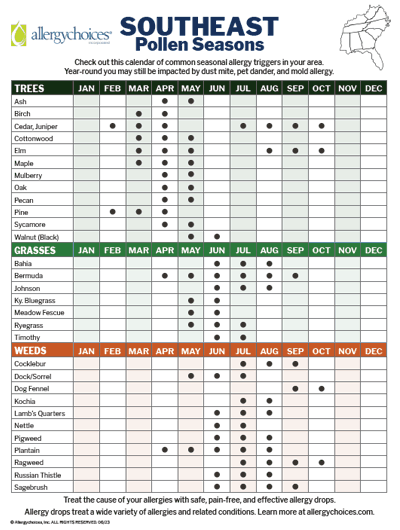
Pollen Allergy Seasons – Alabama, Florida, Georgia, Kentucky, Mississippi, North Carolina, South Carolina, Tennessee, Virginia & West Virginia
Southeast Pollen Allergy Calendar — Find Out When Allergy Seasons End
If you’re tired of chronic allergies and getting temporary relief from meds, or not interested in getting allergy shots, you have a choice! Treat the cause of your allergies with safe, affordable, and pain-free allergy drops right from the comfort of your home.
Most people can’t avoid their allergies. Allergy drops are a safe way to stop suffering, especially for:
- Infants and young children*
- Asthmatics
- Those with chronic conditions including sinusitis and eczema
- People with food and mold allergy
- People with multiple allergies including dust mites, pollen, and animals
Southeast United States — Allergy Season by Month
January
While you aren't dealing with outdoor allergies this time of year, indoor environmental allergens may be causing your allergies to act up such as:
February
Expect to start seeing allergies due to tree pollen such as:
- Cedar/Juniper
- Pine
March
Those with tree allergies may start experiencing symptoms due to pollen from:
- Birch
- Cedar, Juniper
- Cottonwood
- Elm
- Maple
- Pine
April
Tree pollen season is in full swing this time of year with prominent pollen from:
- Ash
- Birch
- Cedar, Juniper
- Cottonwood
- Elm
- Maple
- Mulberry
- Oak
- Pecan
- Pine
- Sycamore
Bermuda grass and plantain weed pollen can become problematic in April.
May
This month can be a struggle for those who deal with tree, grass, and weed allergies.
Prominent tree pollens:
- Ash
- Cottonwood
- Elm
- Maple
- Mulberry
- Oak
- Pecan
- Sycamore
- Walnut (Black)
Prominent grass pollens:
- Bermuda
- Ky. Bluegrass
- Meadow Fescue
- Ryegrass
Prominent weed pollens:
- Dock/Sorrel
- Plantain
Therapy treats the cause — not just symptoms
The goal of allergy drops is to train your immune system to stop reacting to what you’re allergic to. And you can take allergy drops in the convenience of your home or wherever you are. The result?
Reduce or eliminate need for allergy medications


Feel better and participate in life with less lost time from work & play
June
Tree pollen decreases in June, but grass & weed pollen become more common.
Prominent tree pollen:
- Walnut (Black)
Prominent grass pollens:
- Bahia
- Bermuda
- Johnson
- Ky. Bluegrass
- Meadow Fescue
- Ryegrass
- Timothy
Prominent weed pollens:
- Dock/Sorrel
- Lamb’s Quarters
- Nettle
- Pigweed
- Plantain
- Russian Thistle
- Sagebrush
July
Most tree pollen should be gone. Grass and weed pollen are the most common cause of outdoor allergies in July.
Prominent tree pollens:
- Walnut (Black)
Prominent grass pollens:
- Bermuda
- Johnson
- Ryegrass
- Timothy
Prominent weed pollens:
- Cocklebur
- Dock/Sorrel
- Lamb’s Quarters
- Marshelder
- Nettle
- Pigweed
- Plantain
- Ragweed
- Russian Thistle
- Sagebrush
August
Tree pollens:
- Cedar, Juniper
- Elm
Prominent grass pollens:
- Bahia
- Bermuda
- Johnson
Prominent weed pollens:
- Cocklebur
- Kochia
- Lamb’s Quarters
- Pigweed
- Plantain
- Ragweed
- Russian Thistle
- Sagebrush
September
Prominent tree pollen:
- Cedar/Juniper
- Elm
Prominent grass pollen:
- Bermuda
Prominent weed pollens:
- Cocklebur
- Dog Fennel
- Ragweed
- Sagebrush
October
The prominent pollens are:
- Cedar/Juniper
- Elm
- Bermuda grass
- Dog Fennel
- Ragweed
November & December
You may experience allergy symptoms due to indoor allergens such as:
- Dust mite
- Pet dander
- Mold
Treat the cause of your allergies with safe, pain-free, and effective allergy drops.
Allergy drops treat a wide variety of allergies and related conditions.
Check out pollen & mold levels through the National Allergy Bureau.


